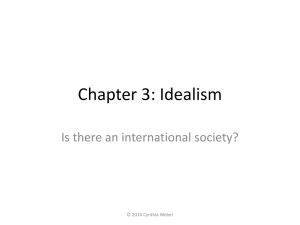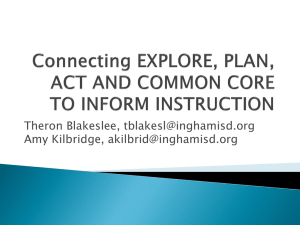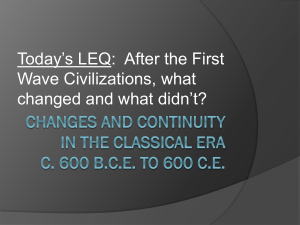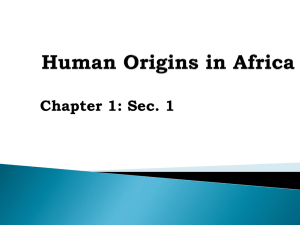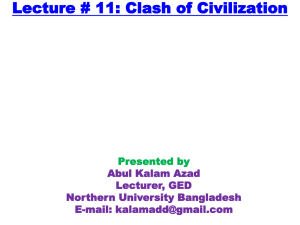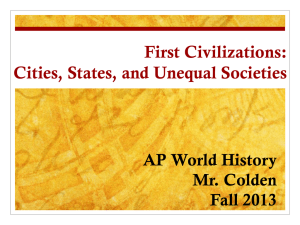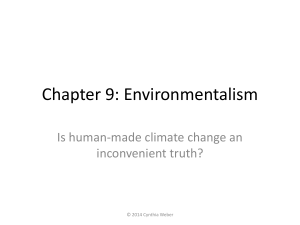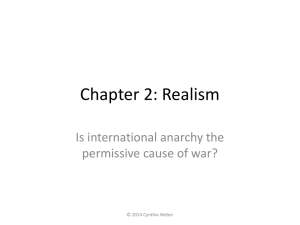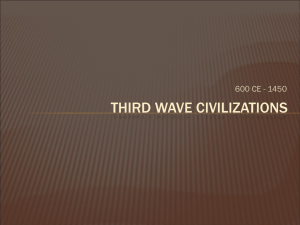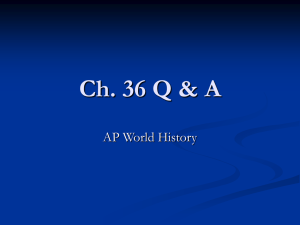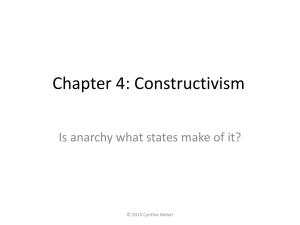Chapter 8: Modernization and development theory
advertisement
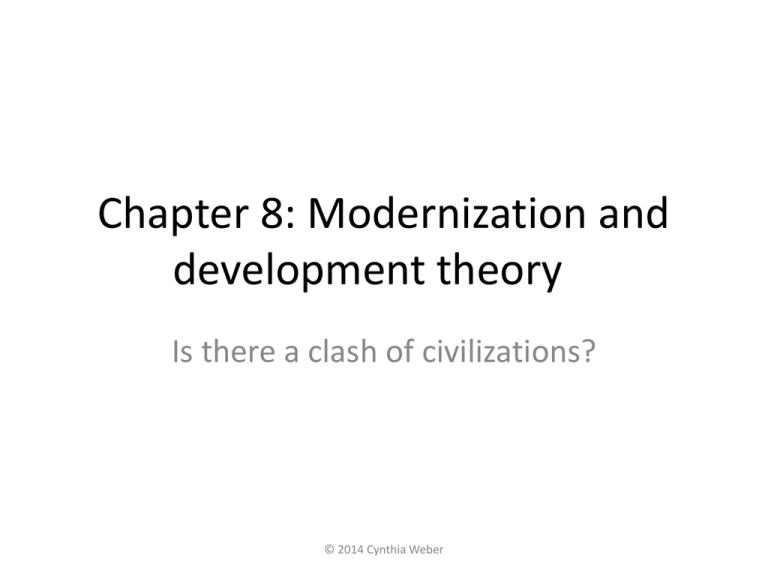
Chapter 8: Modernization and development theory Is there a clash of civilizations? © 2014 Cynthia Weber Learning aims: Understanding the myth “there is a clash of civilizations” Understanding its relationship with theories of modernization and development Seeing how this myth functions in international politics through events like 9/11 Critically interrogating the way it conceptualizes “identity” as a stable category © 2014 Cynthia Weber Last week: NeoMarxism Myth: “Empire is the new world order” Key concepts: Truth, ontology and desire Hardt and Negri’s myth is enabled by a “selective memory” of postmodernism. We do not have to view resistance as coherent for it to be meaningful. © 2014 Cynthia Weber Modernization and development Flashcard Key thinkers: Samuel P. Huntington Key concepts: Gabriel Almond & Bingham Powell Identity Desire Culture Myth: There is a clash of civilizations © 2014 Cynthia Weber Huntington’s “clash of civilizations” 1. What are civilizations? • Common objective elements (language, history, religion, customs, institutions) • Subjective self identification – what you think your are (Italian, catholic, European, Westerner) – but not the same as states! 2. How are civilizations “mapped” onto the world? • 7 or 8 (Western, Confucian, Japanese, Islamic, Hindu, Slavic-Orthodox, Latin American and possibly also African? • These are not justified by Huntington, but taken as a given 3. Why will they be in conflict? • Because they have been historically and because ideological struggles of Cold War cannot subdue civilizations struggle in post-Cold War era • The main fault lines will be between Western Christianity and Islam and between Islam and every other civilization © 2014 Cynthia Weber Structural-functional model (figure 8.1) Domestic environment Inputs State functions (political demands) (interest groups, parties, bureaucracies, legislature, executive, courts) International environment © 2014 Cynthia Weber Outputs (policies) Political development timeline (figure 8.2) Third World states Developing states First World states (traditional) (modernizing) (modern) © 2014 Cynthia Weber Assumptions of political development (table 8.1) Assumptions of political development (table 8.1) General assumptions Assumptions Huntington rejects 1. Change and development are easy 2. All good things go together 2. All good things go together 3. Radicalism and revolution are bad 4. Distributing power is more important than accumulating power (Packenham, 1973) 4. Distributing power is more important than accumulating power © 2014 Cynthia Weber Theory activity: ‘Class of Civilizations’ Aim: To think critically about the notion that identities are stable as a means to interrogate the ‘clash of civilizations’ myth. • As a full group, go around the room and ‘map’ identities. Note your ‘identities’ (in no particular order) (5 min.). • Think about stability across time and space and note this in the table. • Then discuss the following questions (5 min.): – Which of these identities would ‘clash’ in Huntington’s myth? – What do these ‘identities’ tell us about the nature of ‘identities’ themselves? – If we cannot assume stable categories of identities, what does this do to Huntington’s myth of the ‘clash of civilizations’? Identity Stability across time? Stability across place? Cultural, religious, social, sexual, racial etc. Yes/no Yes/no © 2014 Cynthia Weber How East is East makes sense of the world (box 8.1) 1. George/Islam and Ella/Western Christianity clash over their bi-cultural children who represent the fault lines between these civilizations Or 2. The Khan children do not represent the fault lines between Western Christianity and Islam but foreshadow the multicultural Britain emerging in the postcolonial era © 2014 Cynthia Weber The family in East is East The parents: • George (dad) • Ella (mum) The kids: • Young Sajid cocoons himself from the struggles facing his elder siblings with his parka and his age • Meenah is a tomboy • Saleem is an art student passing as an engineering student to his father but “out” to his mother • Maneer, who his siblings have nicknamed Gandhi, follows Islamic traditions more closely than the others, although even he took part in the opening Catholic procession • Tariq is the clubber who fancies himself a bit of a playboy and certainly not a “Paki” • Abdul is the most independent of the children remaining at home, negotiating racism in the workplace and attempting to respect his mother and his father at home so he can hold onto his family • And Nazir, who refused to marry in the first scene, turns up later in the film as a gay hairdresser working in his boyfriend's fancy salon © 2014 Cynthia Wber What is typical and deviant in the world of East is East? (table 8.2) Typical Deviant For George’s values and Ella’s values to respectfully coexist within the Khan family (even if in this patriarchal 1970s household, Ella’s values and the children’s respect for them must be concealed For George to force his children to become fully integrated into his culture © 2014 Cynthia Weber Film activity: The ‘Khan Kids’ in East is East Aim: To to reflect on how different the Khan kids are as a means to critically interrogate the ‘clash of civilizations’. • In SMALLER GROUPS note down the different characteristics of the Khan kids (5 min.) • Think about their differences in dress and appearance, language, demeanour, desires etc. • As a WHOLE GROUP, discuss what these differences tell us about the Huntington’s ‘clash of civilizations’. Discuss the following: (5 min.) – How is it that these children are so different if they come from the same ‘civilization’? – Which ‘civilization’ do they come from? Is it one of Huntington’s 7-8 civilizations? – How does the film help© 2014 us Cynthia think about identities as unstable? Weber Next week: Environmentalism Green politics Climate Change Film: WALL-E Truth Is human-made climate change an inconvenient truth? © 2014 Cynthia Weber
